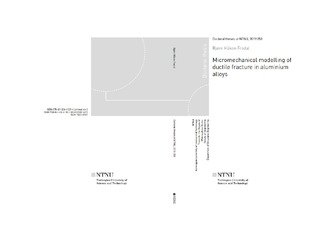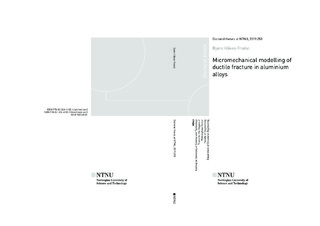| dc.description.abstract | To predict the behaviour of structural components, engineers often rely on numerical modelling and simulation to describe the mechanical response and failure. For an accurate assessment of the structural response, predictive numerical models are essential. A critical step for better and more physical-based damage and fracture models is improved understanding and quantitative description of the ductile fracture process. Understanding the physical mechanisms at the microscopic scale and the role of the microstructure in metallic materials are thus fundamental. Numerical modelling and simulation on the nano-, micro- and mesoscales assisted by advanced experimental characterization can contribute to a more profound knowledge of the physical phenomena governing damage evolution and ductile failure in materials. As such, this PhD thesis consists of experimental and numerical studies regarding the ductile fracture of aluminium alloys.
Part 1 presents an entirely experimental study, investigating the influence of pre-compression on the strain to failure by reversed loading tests on three aluminium alloys (AA6060, AA6082.25 and AA6082.50) in the peak strength condition (temper T6). The three alloys have different grain structure and crystallographic texture. Diabolo-shaped specimens oriented along the transverse direction of an extruded profile are used and subjected to five different levels of pre-compression (0, 10, 20, 30, 40%) before they are continuously pulled to fracture in tension. It is found that pre-compression has a marked influence on the ductility of the aluminium alloys and that it depends on the microstructure and strength of the material. A fractographic analysis is performed on the reversed loading specimens in order to get a deeper understanding of the ductile fracture mechanisms. In the reversed loading experiments, the tensile ductility is observed to be approximately constant, exhibits a small increase or a large increase, depending on the alloy.
Additional experimental results using reversed loading tests on diabolo-shaped specimens are presented in Part 2. The three aluminium alloys, AA6060, AA6082.25 and AA6082.50 are solution heat-treated and artificially aged to three conditions, namely temper O (annealed), temper T7 (overaged) and temper T6 (peak strength). The reversed loading experiments are performed using five different levels of pre-compression (0, 10, 20, 30, 40%) before the load is reversed and the specimens are pulled to fracture in tension. With an advanced plasticity model accounting for plastic anisotropy, non-associated plastic flow, nonlinear isotropic and kinematic hardening, strength differential effect, and transient and permanent effects of strain path change, the tests are modelled using nonlinear finite element based simulations. The plastic anisotropy is found based on crystal plasticity finite element analyses and unit cell simulations, where the non-proportional loading histories from the reversed loading tests are used to investigate ductile fracture. The strain to coalescence from the unit cell is mapped back to the test specimen, used to determine the failure strain, and compared with the experimental findings.
In Part 3, the effects of plastic anisotropy, strength and work hardening on the ductility of aluminium alloys are investigated using nonlinear finite element simulations and strain localization analyses of tensile tests in different material orientations. The three aluminium alloys (AA6060, AA6082.25 and AA6082.50) are considered in addition to an isotropic material represented by an isotropic high-exponent yield surface. The yield surfaces of these alloys are combined with three flow stress curves representative for the different ageing treatments in Part 2, resulting in a range of relevant model materials with different plastic anisotropy, strength and work hardening used in the numerical investigations. Finite element simulations are carried out on tensile tests in seven in-plane directions, i.e., 0_, 15_, 30_, 45_, 60_, 75_ and 90_ to the extrusion direction, and the non-proportional loading histories are used in the subsequent strain localization analyses. In agreement with previous experimental evidence, plastic anisotropy is found to have a marked influence on the tensile ductility and to induce fracture anisotropy. Further, the influence of strength and work hardening is found to depend on the plastic anisotropy.
The role of the quench rate on the plastic flow and ductile fracture of aluminium alloys is investigated in Part 4. The three age hardenable aluminium alloys AA6060, AA6082.25 and AA6082.50 are subjected to different quench rates after the solution heat-treatment (either water quenching or air cooling), and the impact on the precipitate microstructure and the mechanical properties is studied. Tensile tests on smooth and Vnotch specimens and Kahn tear tests are performed to study the influence of stress state on plastic flow and fracture. Transmission electron microscopy (TEM) investigations show that the alloys and their precipitation microstructure are differently affected by the quench rate. As a result of the observed lower yield strength and higher work-hardening rate after air cooling, the strain to failure is increased for the smooth and V-notch tensile tests. Depending on the grain structure and plastic anisotropy, the crack propagation energy, calculated from the Kahn tear tests, is differently affected by the quench rate. In addition, finite element simulations of the mechanical tests are performed, using an extension of the Gurson model to high-exponent anisotropic plasticity, for one of the alloys. The anisotropic porous plasticity model is able to precisely capture fracture initiation in all the specimen geometries. On the other hand, the crack propagation energies of the Kahn tear tests are slightly overestimated. | nb_NO |

